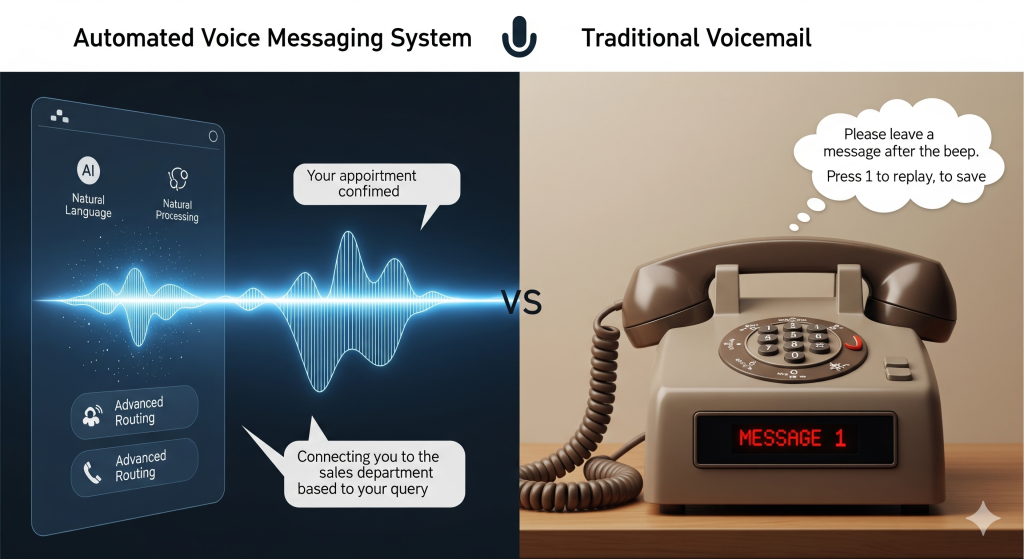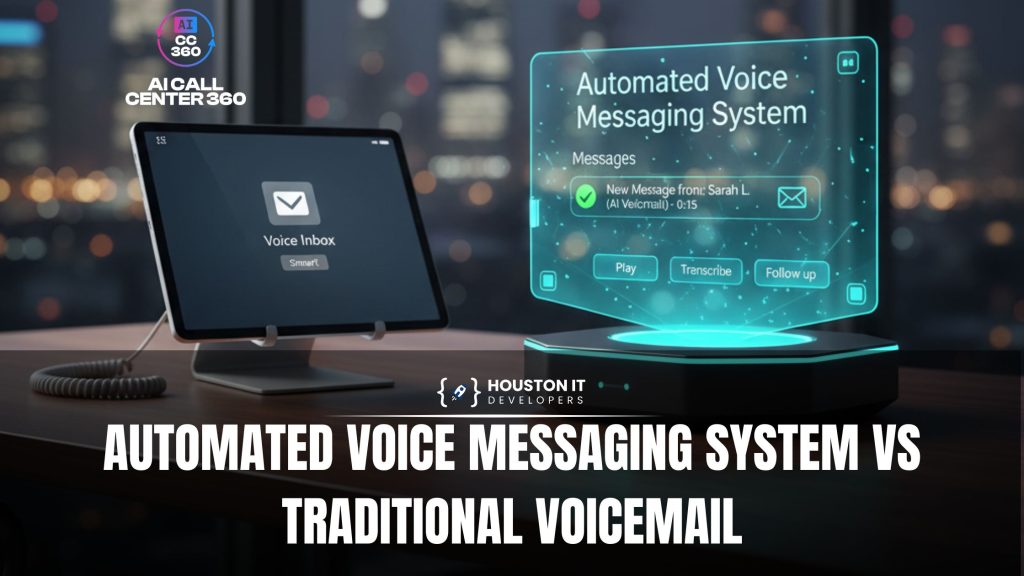Have you ever wondered why so many customer calls end up in voicemail and never get a reply? With 80 to 97% of calls now going straight to voicemail and average response rates hovering around just 5%, businesses are losing valuable opportunities. An automated voice messaging system changes this dynamic by ensuring every caller receives timely and personalized communication.
Studies show that more than 67% of businesses already use solutions like automated voicemail drops to save time, reduce costs, and keep customers engaged. The challenge with traditional voicemail is that messages often sit unheard or are quickly skipped in favor of text transcriptions. This gap leaves customers frustrated and businesses at risk of missing leads.
In this blog post, we will compare traditional voicemail with modern automated voice messages and AI voicemail messages to help you decide which approach is best for your business.
What Is a Traditional Voicemail System?
A traditional voicemail system is a telecommunication feature that allows callers to leave a recorded message when their call is not answered. The process is straightforward: the phone rings, no one is available, and the caller records a short message that the recipient can later retrieve.
While it has been a staple in business and personal communication for decades, it now shows its age in today’s fast-moving, customer-first environment where instant responses are expected. Unlike an automated voice messaging system, which proactively manages interactions, traditional voicemail only stores messages without offering smart engagement or automation.
Some of the main drawbacks include:
- Manual retrieval of messages: Employees must dial in or access a system to listen to each voicemail, which wastes time and delays replies. In busy industries, these delays often mean losing potential leads or frustrating customers who expect quick action.
- Limited ability to personalize or automate follow-ups: A traditional system simply records a message without options for tailored responses or scheduled callbacks. This lack of flexibility prevents businesses from providing the same seamless service that an automated voice message or AI voicemail message can deliver.
- Inconsistent customer experience depending on staff availability: If staff are busy, away, or fail to check messages promptly, customers may be left waiting without acknowledgment. This inconsistency damages trust and can drive customers to competitors who offer faster, more reliable communication.
- Increased chance of missed opportunities if messages are ignored or forgotten: Voicemails can pile up, become buried, or be accidentally deleted. When businesses fail to respond quickly, they risk losing valuable inquiries, sales, or support requests that an automated system would have addressed immediately.
In essence, a traditional voicemail system functions as a passive tool. It only captures messages but does not help businesses respond with the intelligence, speed, or personalization that modern communication tools like an automated voice messaging system can provide.
What Is an Automated Voice Messaging System?
An automated voice messaging system is a modern communication solution that uses artificial intelligence and automation to handle calls more efficiently than traditional voicemail. Instead of merely recording a message, it can send a personalized automated voice message to acknowledge the caller, route the inquiry to the right department, and even provide immediate responses based on caller needs. This system transforms voicemail from a passive storage tool into an active engagement platform.
Here is what sets automated systems apart:
- Instant customer acknowledgment: When a call goes unanswered, the system sends a pre-recorded or AI-generated reply right away. This creates a professional impression and reassures the caller that their request is being processed without delay.
- Personalized communication with AI voicemail messages: Businesses can craft tailored responses that reflect the caller’s history, preferences, or account details. For example, an AI voicemail message can address the customer by name or reference a previous order, creating a stronger connection.
- Intelligent routing and automation: The system can detect the reason for a call and forward it to the right team or department. This reduces miscommunication and ensures issues are resolved faster than with a manual voicemail retrieval process.
- 24/7 availability: Unlike human staff, an automated voice messaging system never takes a break. Customers who call after business hours still receive professional responses, which helps businesses appear reliable and attentive.
- Analytics and performance tracking: Beyond message delivery, the system can track response times, customer sentiment, and call outcomes. These insights give businesses a clear view of how effective their communication is and where improvements are needed.
With these capabilities, an automated system goes beyond message-taking. It strengthens customer relationships, improves operational efficiency, and reduces the chance of missed opportunities that are common with traditional voicemail.
Key Differences in Efficiency, Customer Satisfaction, and ROI

When comparing a traditional voicemail system with an automated voice messaging system, the differences stand out immediately. Traditional voicemail remains simple but outdated, demanding manual effort and offering little in terms of speed or personalization.
In contrast, automated systems add efficiency and intelligence to customer communication. Tools such as automated voice messages and AI voicemail messages enable businesses to respond faster, engage customers on a deeper level, and achieve stronger financial returns.
| Factor | Traditional Voicemail | Automated Voice Messaging System |
| Efficiency | Requires manual listening, transcription, and follow-up. Delays are common and staff time is wasted. | Provides instant replies, intelligent routing, and fewer missed leads with automated workflows. |
| Customer Satisfaction | Callers often wait hours or days for responses, leading to frustration and lost trust. | Sends immediate acknowledgment through personalized automated or AI voicemail messages, creating a better customer experience. |
| ROI | Low upfront costs but long-term inefficiencies reduce revenue potential and increase churn. | Higher initial investment but delivers measurable ROI through faster response times, stronger lead conversion, and improved retention. |
In summary, an automated voice messaging system outperforms traditional voicemail in every key area of communication. It saves staff time, ensures customers receive prompt acknowledgment, and drives revenue through faster, more reliable engagement.
Shifting from a passive voicemail setup to active interaction with AI voicemail messages turns missed calls into opportunities for stronger relationships and business growth. If you want to explore more ways to prevent missed calls from hurting your bottom line, take a look at this guide on business phone solutions that fix missed calls.\
Which Option Is Best for Your Business?
Choosing between a traditional voicemail system and an automated voice messaging system depends on how your business communicates and the volume of customer interactions. Traditional voicemail still has value in certain situations, but automation brings advanced features that elevate responsiveness and customer satisfaction.
- Small businesses with minimal call traffic can rely on traditional voicemail as a simple backup tool.
- Companies managing larger call volumes benefit from an automated voice messaging system that delivers automated voice messages instantly.
- Organizations focused on customer service excellence can use AI voicemail messages to personalize responses and reduce missed opportunities.
- Businesses in competitive markets gain an advantage through faster replies, better data insights, and improved lead capture.
The most effective approach often blends both systems. Traditional voicemail ensures that no message is ever lost, while automation adds speed, personalization, and intelligence. Together, they create a communication strategy that supports growth and builds stronger customer relationships.
You can take it a step further by harnessing emerging tools like AI-powered voice cloning, which can elevate your automated voice messaging system even more. Learn how voice copy technology is transforming customer service in this insightful article on AI voice cloning for customer service.
Transform Customer Engagement with AI Call Center 360

AI Call Center 360 isn’t just another call-handling system. It’s your business’s new AI-powered employee, available 24/7, trained with your products, prices, and brand identity, and able to speak with your customers just like you would.
Why Businesses Choose AI Call Center 360
| Feature | AI Call Center 360 | Traditional Call Center |
| Availability | 24/7, no breaks or shifts | Limited hours, shift-based |
| Call Handling Speed | Instant, no holds | Often delayed or on hold |
| Cost | Flat-rate pricing | High hourly or per-call fees |
| Call Recording & Transcripts | Automatic | Often extra cost |
| CRM Integration | Real-time syncing | Limited or delayed |
| Caller Experience | Human-like, clear, consistent | Varies by agent |
| Language Support | 20+ languages built in | Limited |
| Custom Call Behaviour | Fully brand-trained | Minimal flexibility |
| Business Phone Line | Included | Extra cost |
| Training | Upload docs, scan website, instant setup | Long onboarding and manual scripts |
What Your AI Can Do
| Capability | Description |
| AI Phone Answering | Handles every customer call in real-time with human-like accuracy. |
| Voice Cloning | Makes your AI sound like you, literally. |
| Lead Capture | Turns inquiries into qualified leads instantly. |
| Appointment Booking | Schedules calls, demos, or meetings for your team. |
| CRM Integration | Syncs all calls, leads, and notes directly to your system. |
| Call Summaries | Creates clear summaries with key takeaways for your records. |
| Multi-language Support | Communicates in over 20 languages. |
| Analytics Dashboard | Tracks calls, leads, and conversion performance. |
| Custom AI Training | Adapts to your products, FAQs, and brand personality. |
Frequently Asked Questions
What is an automated voice messaging system message?
An automated voice messaging system message is a pre-recorded or AI-generated response that answers calls when you are unavailable. It can share important details like business hours, direct callers to the right department, or collect information for follow-up. With AI Call Center 360, these messages go further by responding in real time and adapting to customer needs.
What does it mean when your call is forwarded to an automated voice message system?
When a call is forwarded to an automated voice message system, it means the call wasn’t answered by a live person and has been redirected to the system. This could allow the caller to leave a voicemail, hear a preset message, or interact with an AI assistant like AI Call Center 360 that can instantly provide support.
How do I set up an automated voice message?
Traditionally, setting up involves recording a greeting or uploading an audio file through your phone system’s settings. With AI Call Center 360, setup is quick and intelligent. You can connect your website or upload service documents, and the AI immediately learns how to answer calls, share accurate information, and even schedule appointments without lengthy recordings.
Final Thoughts on Automated Voice Messaging System vs Traditional Voicemail
The choice between a traditional voicemail system and an automated voice messaging system comes down to business priorities. Voicemail still offers basic coverage, but it is limited, passive, and often slow to meet modern customer expectations. Automated solutions, on the other hand, provide instant acknowledgment, personalization through AI voicemail messages, and valuable insights that drive revenue and loyalty.
If your goal is to save time, reduce missed opportunities, and deliver 24/7 customer engagement, an automated voice messaging system is the smarter investment. AI Call Center 360 makes this transition simple with real-time AI-powered responses, seamless CRM integration, and custom training based on your brand.
Don’t let another customer call go unanswered. Sign up today and experience AI Call Center 360 for yourself. Download the app now from the App Store or Google Play and transform every call into an opportunity.


